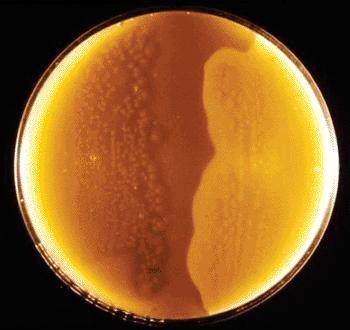Bacterium Evaluated as Potential Multiple Sclerosis Trigger
By LabMedica International staff writers
Posted on 06 Nov 2013
A bacterium has been identified that may trigger multiple sclerosis (MS), a chronic, debilitating disorder that damages myelin forming cells in the brain and spinal cord.Posted on 06 Nov 2013
Clostridium perfringens type B, an epsilon toxin-secreting bacillus, has been isolated for the first time from a young woman at clinical presentation of MS with actively enhancing lesions on brain seen by magnetic resonance imaging (MRI).

Image: Clostridium perfringens colonies cultured on a half-antitoxin plate (Photo courtesy of Dr. Stuart E. Starr).
A scientific team from Weill Cornell Medical College (New York, NY, USA) tested banked blood and spinal fluid (CSF) from both MS patients and healthy controls for antibody reactivity to the epsilon toxin (ETX). Western blots were performed using human sera or CSF as the primary antibody. They found that levels of epsilon toxin antibodies in MS patients were 10 times higher than in the healthy controls, as the blood of only one out of 100 control participants showed an immune reaction to the toxin.
The team also examined stool samples from both 30 MS patients and 31 healthy controls enrolled in a clinical study. The mean age of healthy controls was 46.7 years and the mean age of MS subjects was 42.0 years. Of the healthy controls, 14 of 31 were female, and of the MS subjects, 22 of 30 were female. The investigators found that 52% of healthy controls carried the C. perfringens A subtype compared to 23% of MS patients. For CSF, 6 of 62 MS patients, and 1 of 40 controls, were positive for ETX immunoreactivity. For the analysis of sera, 6 of 56 MS patients, and none of the 60 controls were seroreactive to ETX.
Timothy Vartanian, MD, PhD, a professor of neurology and neuroscience, said, “While it is clear that new MS disease activity requires an environmental trigger, the identity of this trigger has eluded the MS scientific community for decades. Work is underway to test our hypothesis that the environmental trigger for MS lays within the microbiome, the ecosystem of bacteria that populates the gastrointestinal tract and other body habitats of MS patients.”
Professor Vartanian added, “We are also investigating the possibility of developing small-molecule drugs that prevent the toxin from binding to its receptor. But one of my favorite approaches is development of a probiotic cocktail that delivers bacteria that compete with, and destroy, C. perfringens types B and D. It would be such a beautiful and natural way to treat the gastrointestinal system and solve the problem. We are also starting to work on this approach.” The study was published on October 16, 2013, in the journal Public Library of Science ONE.
Related Links:
Weill Cornell Medical College














